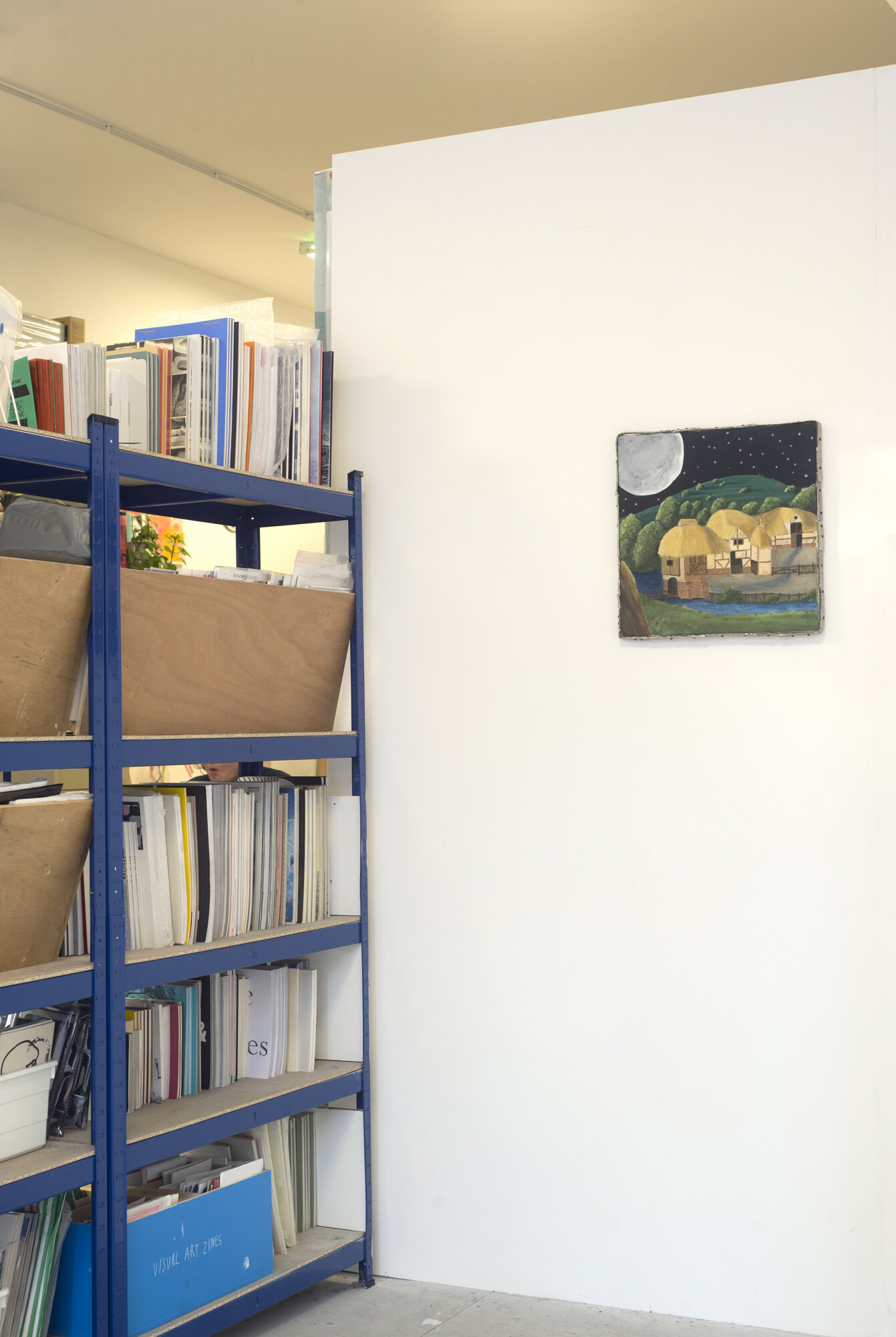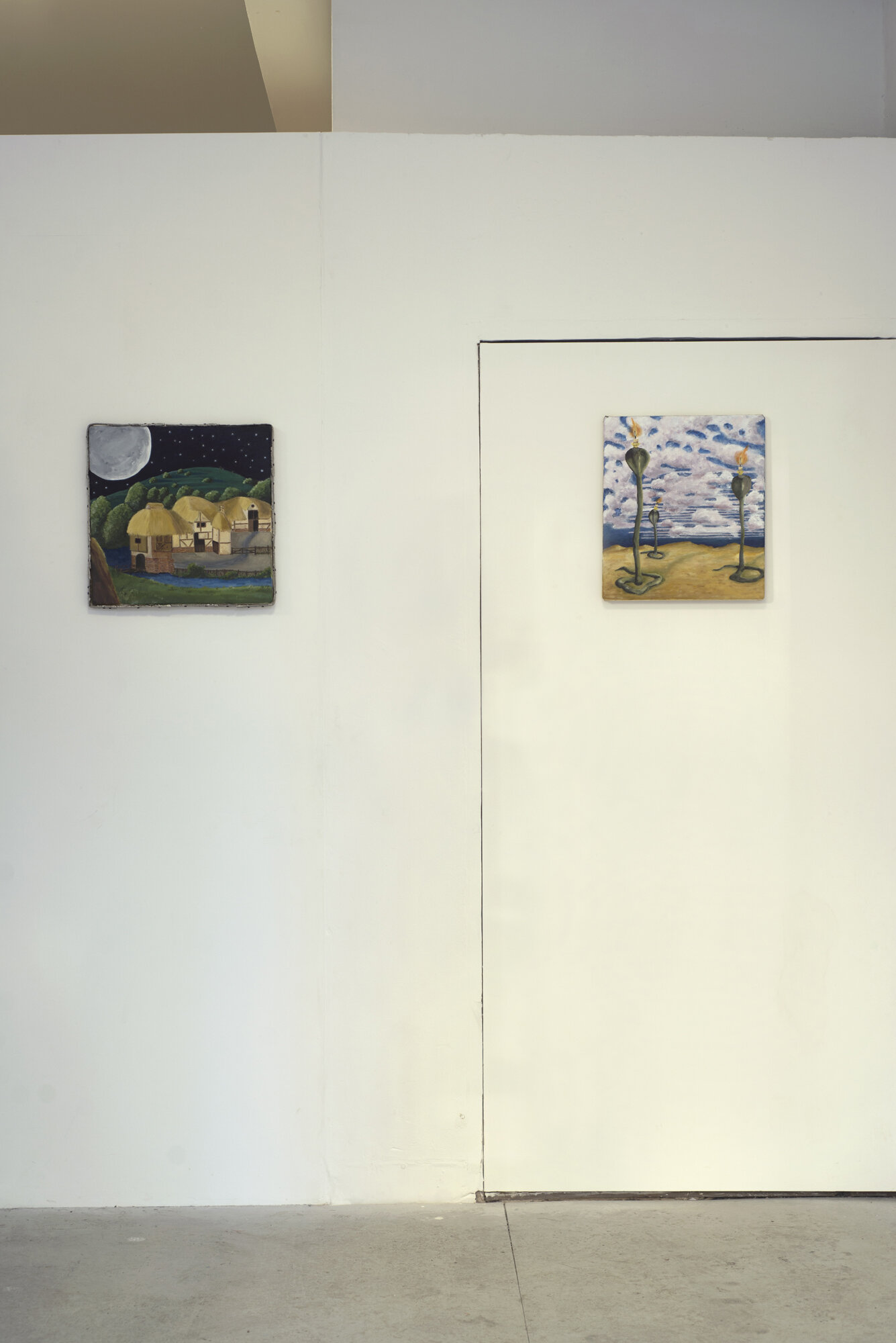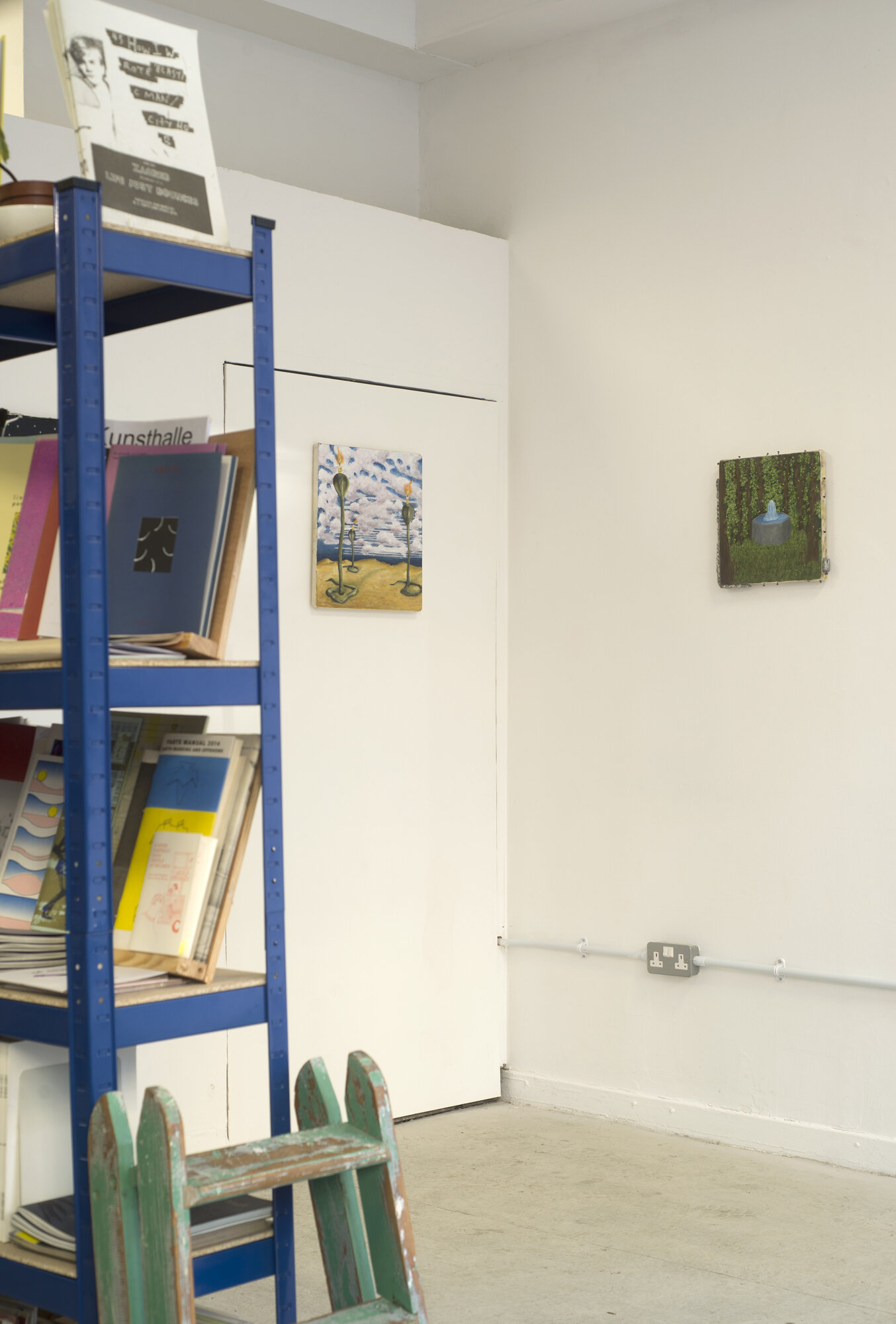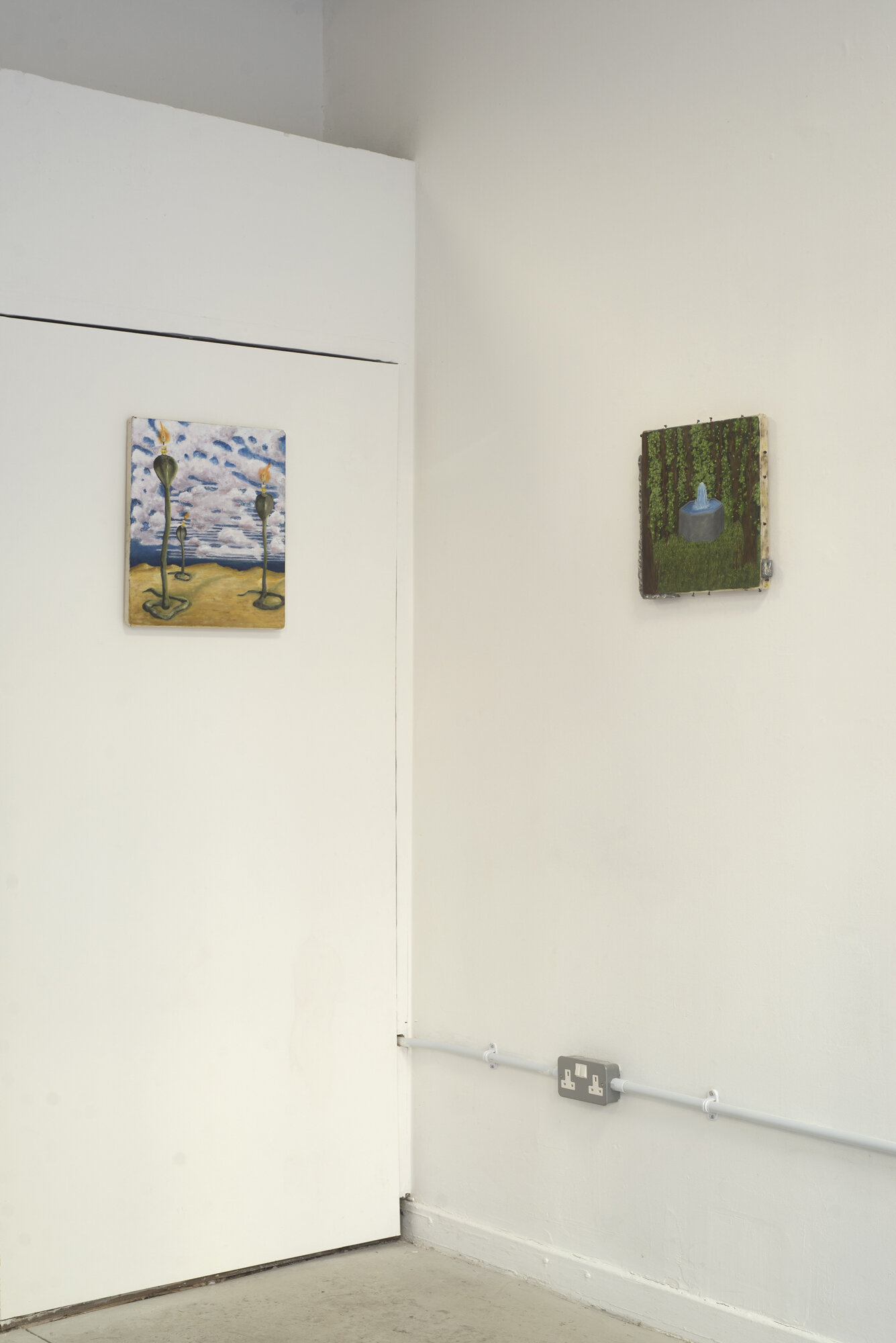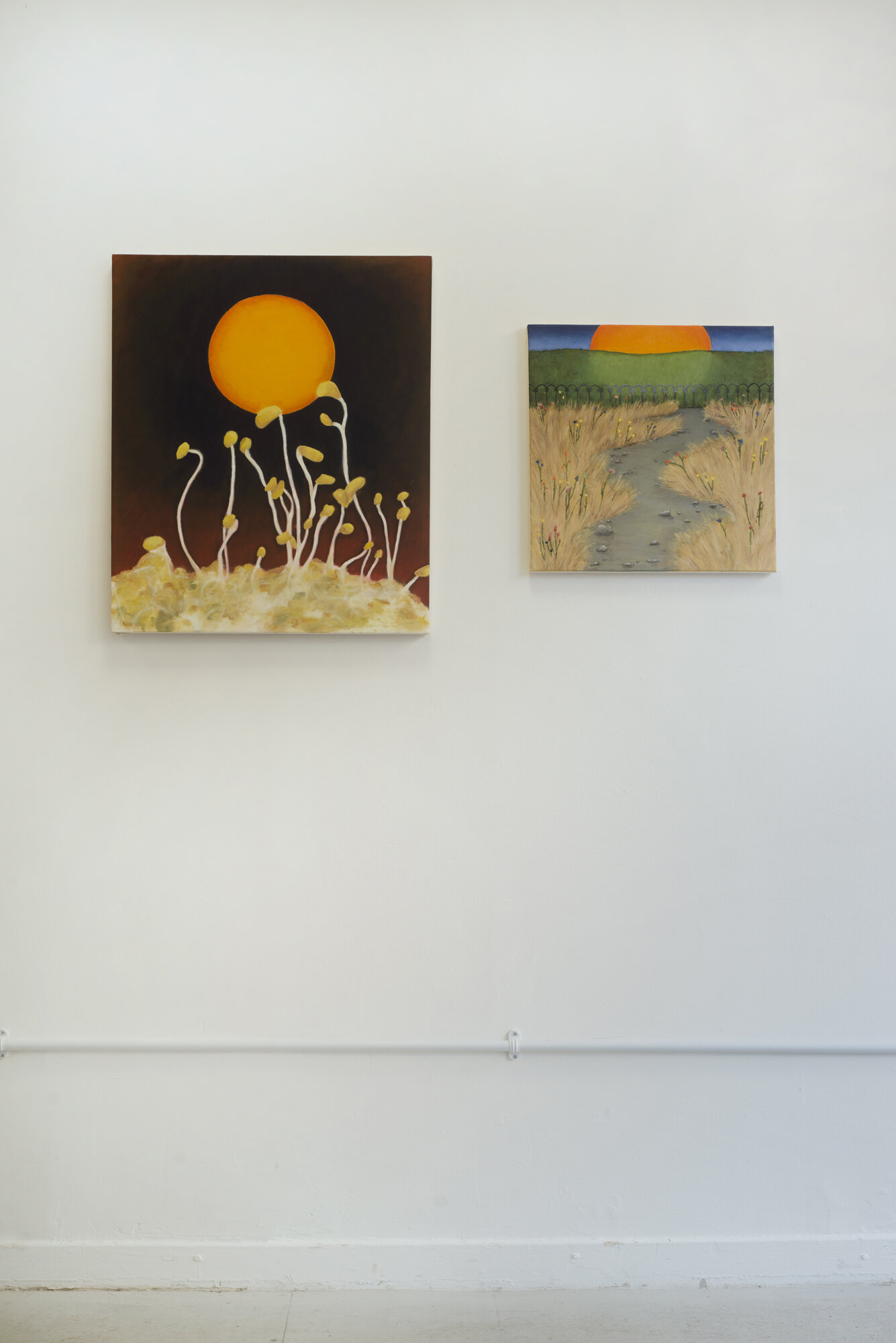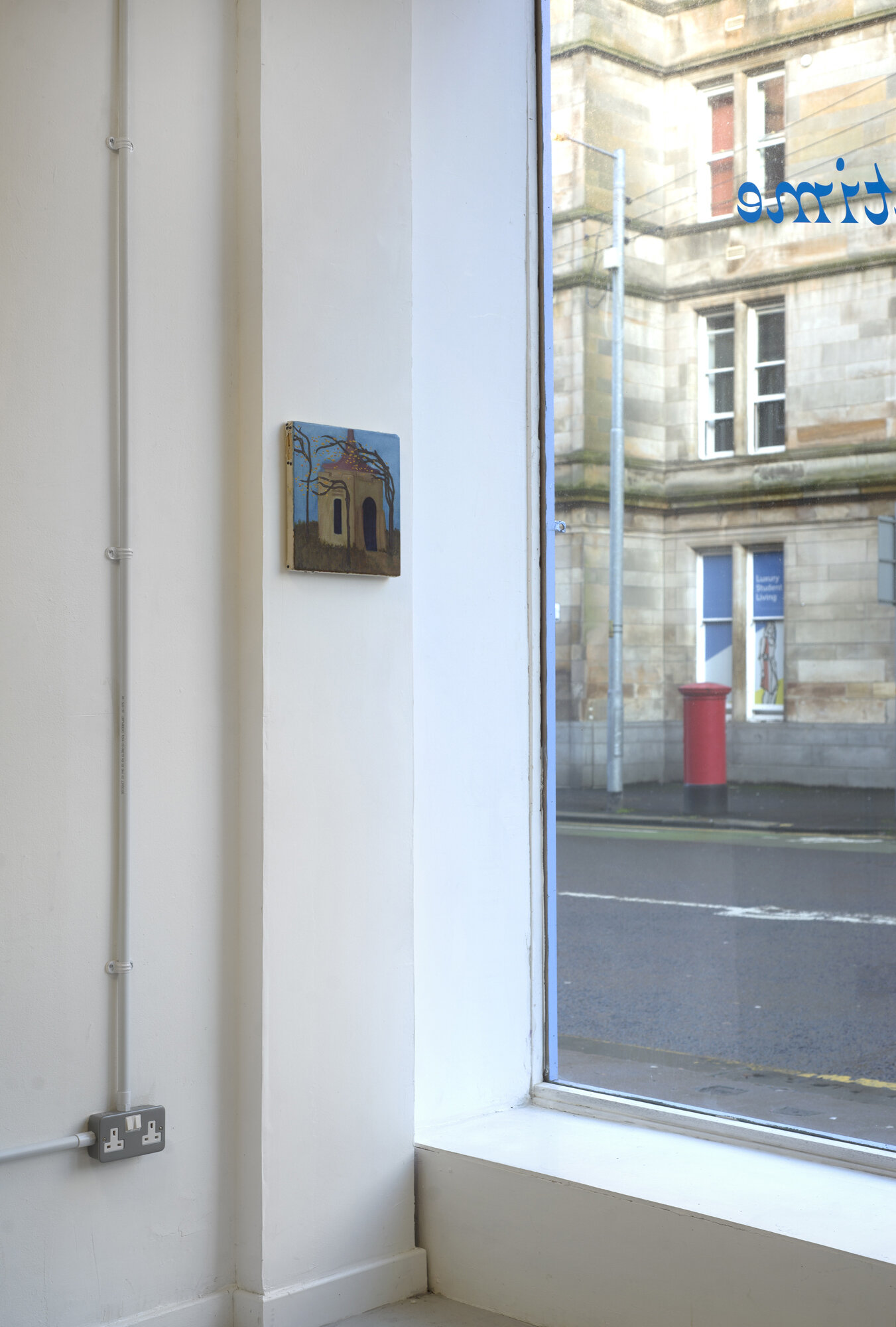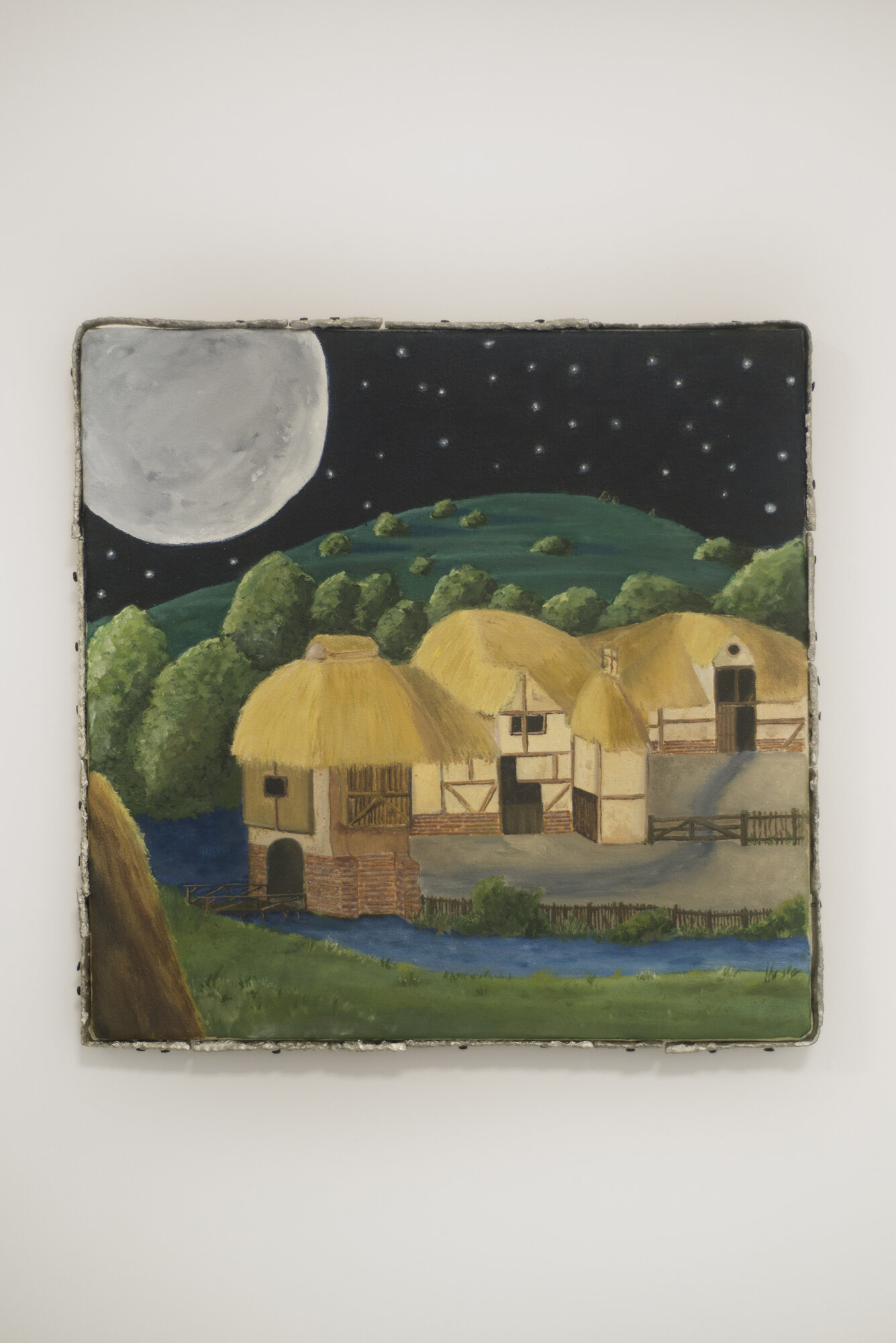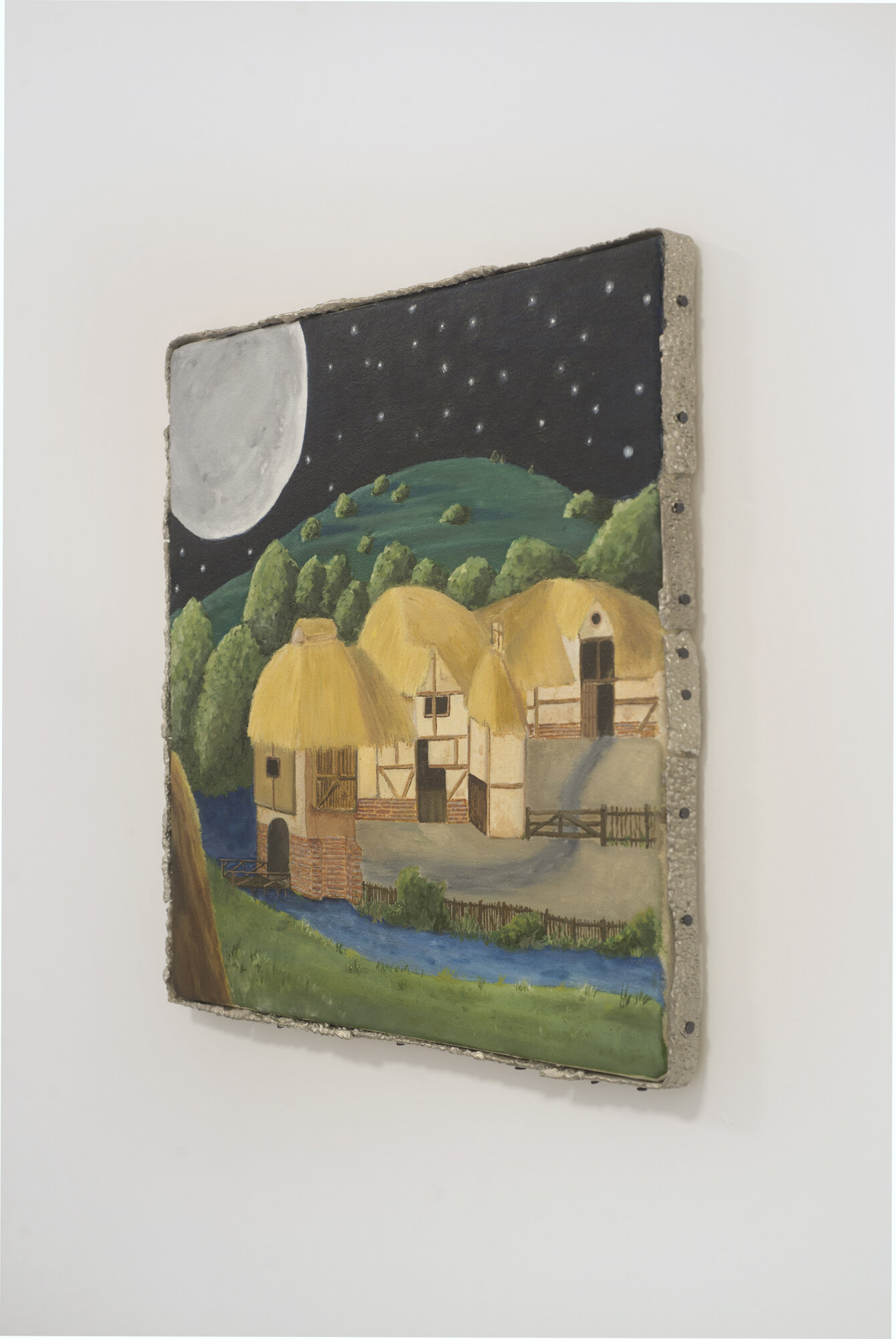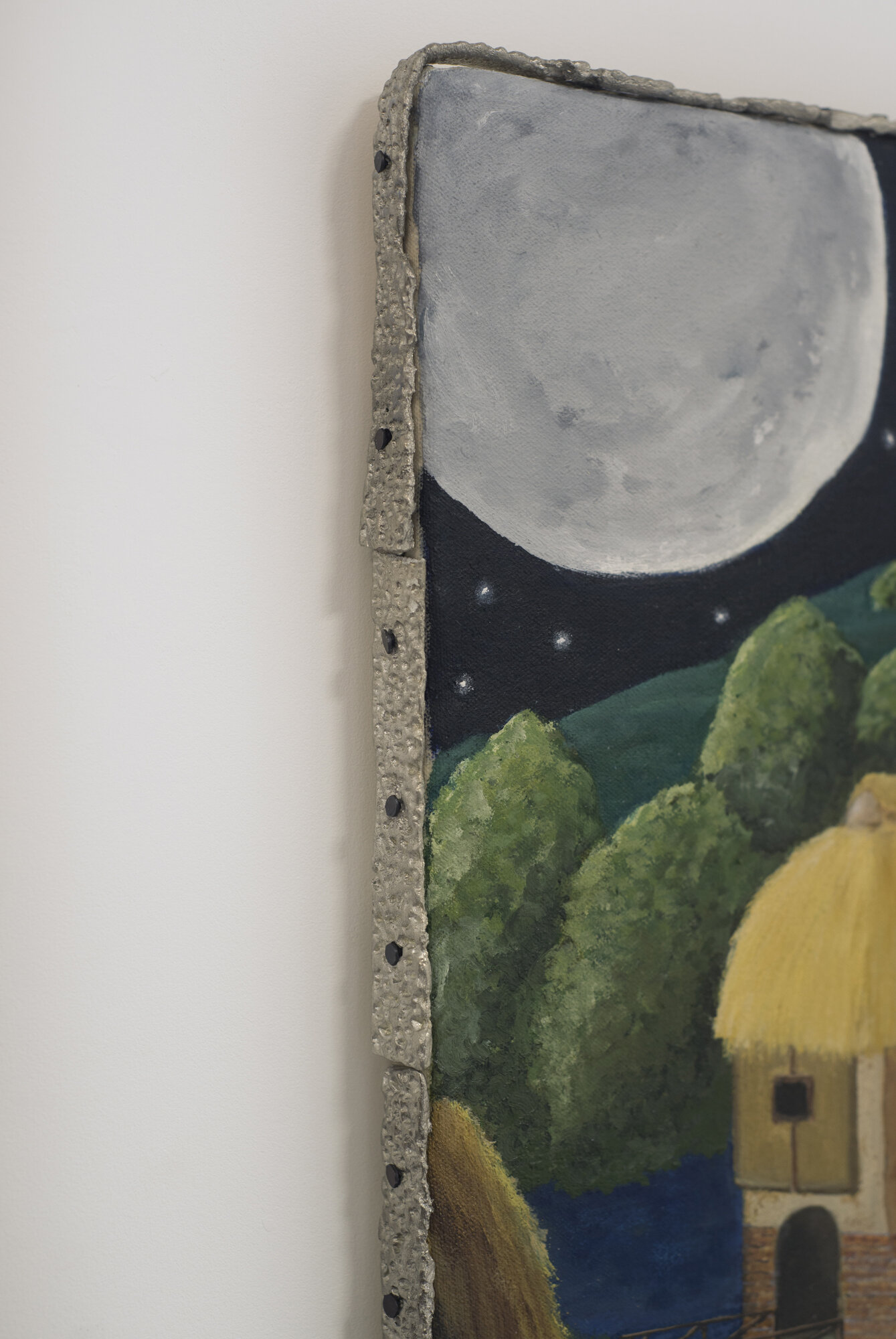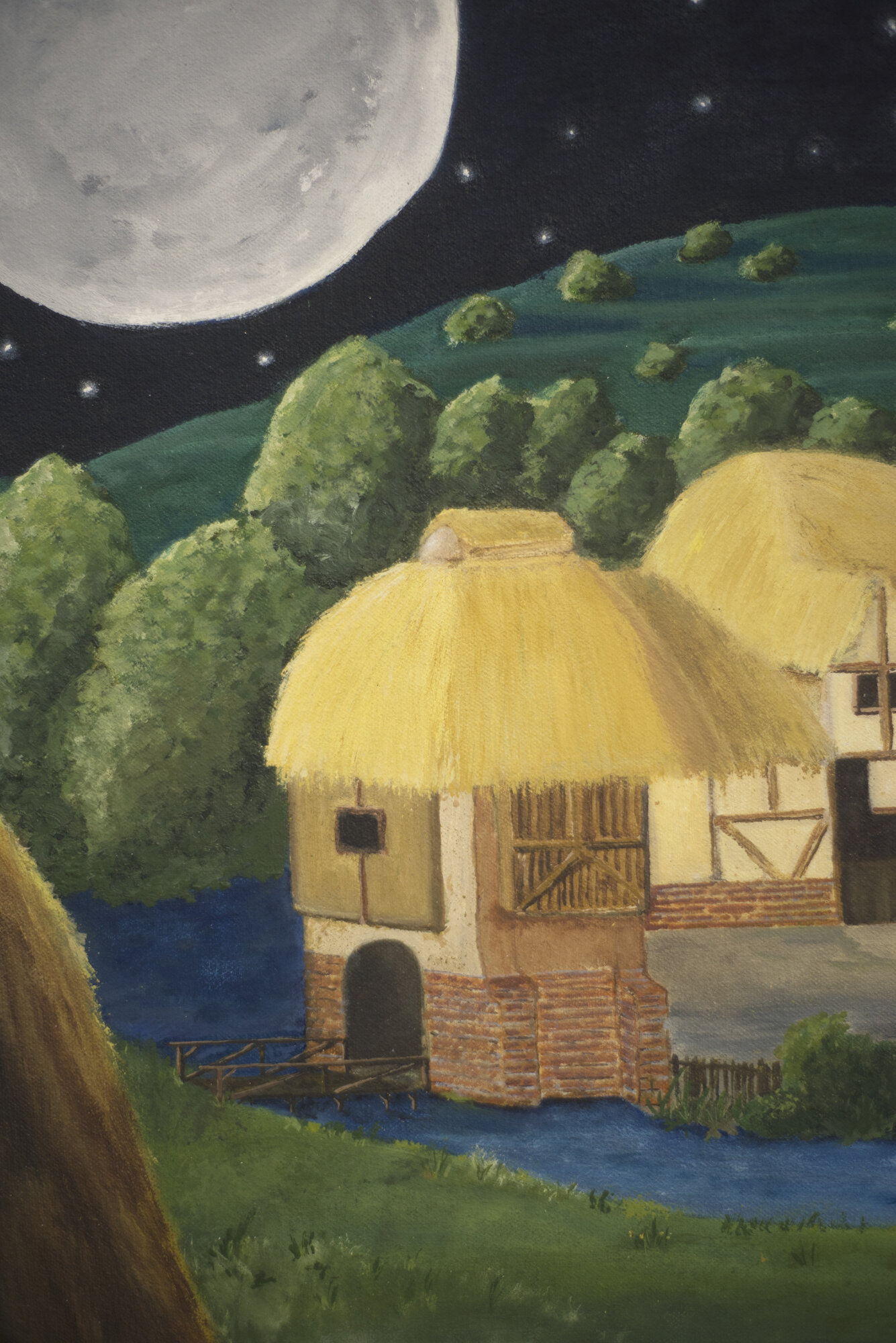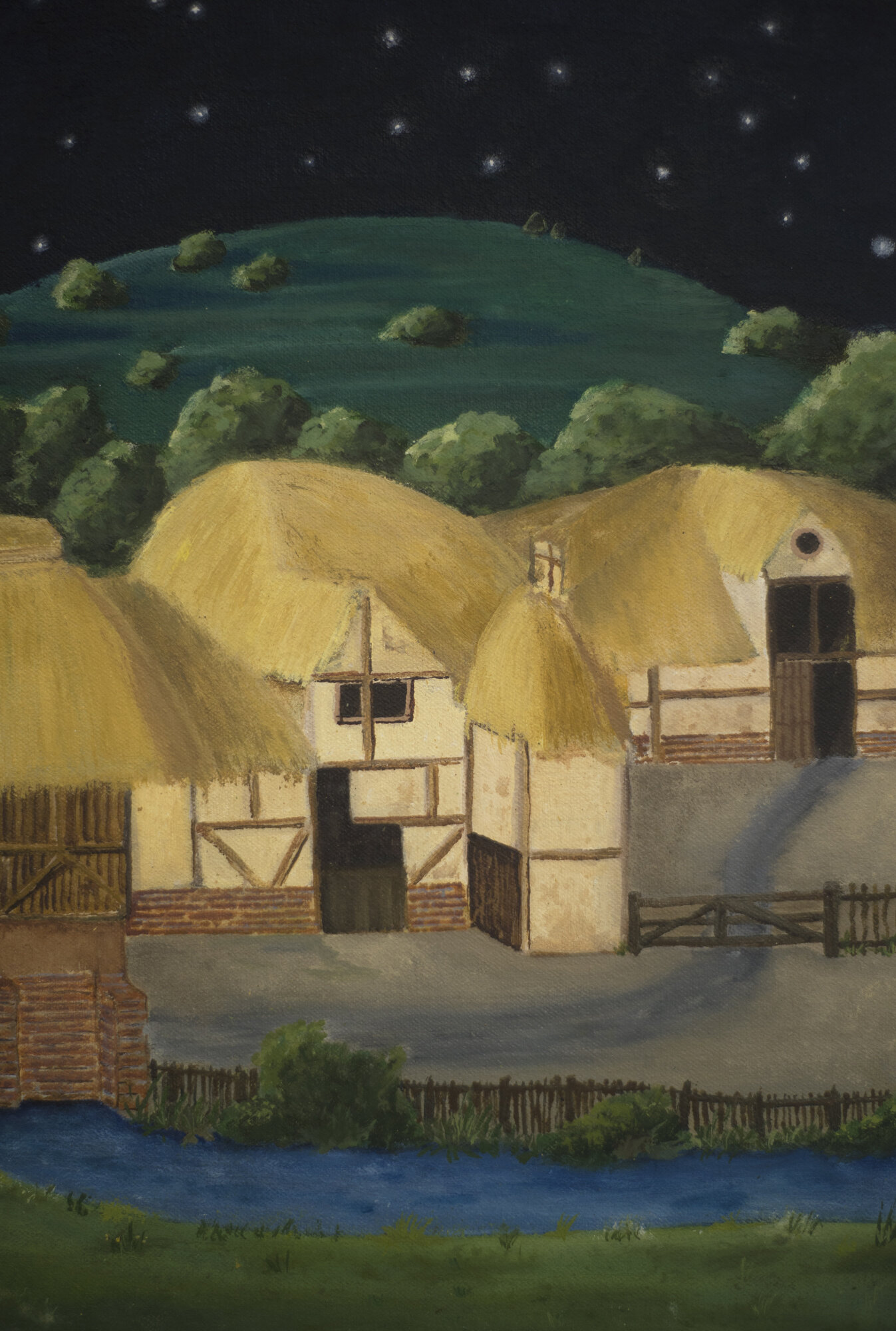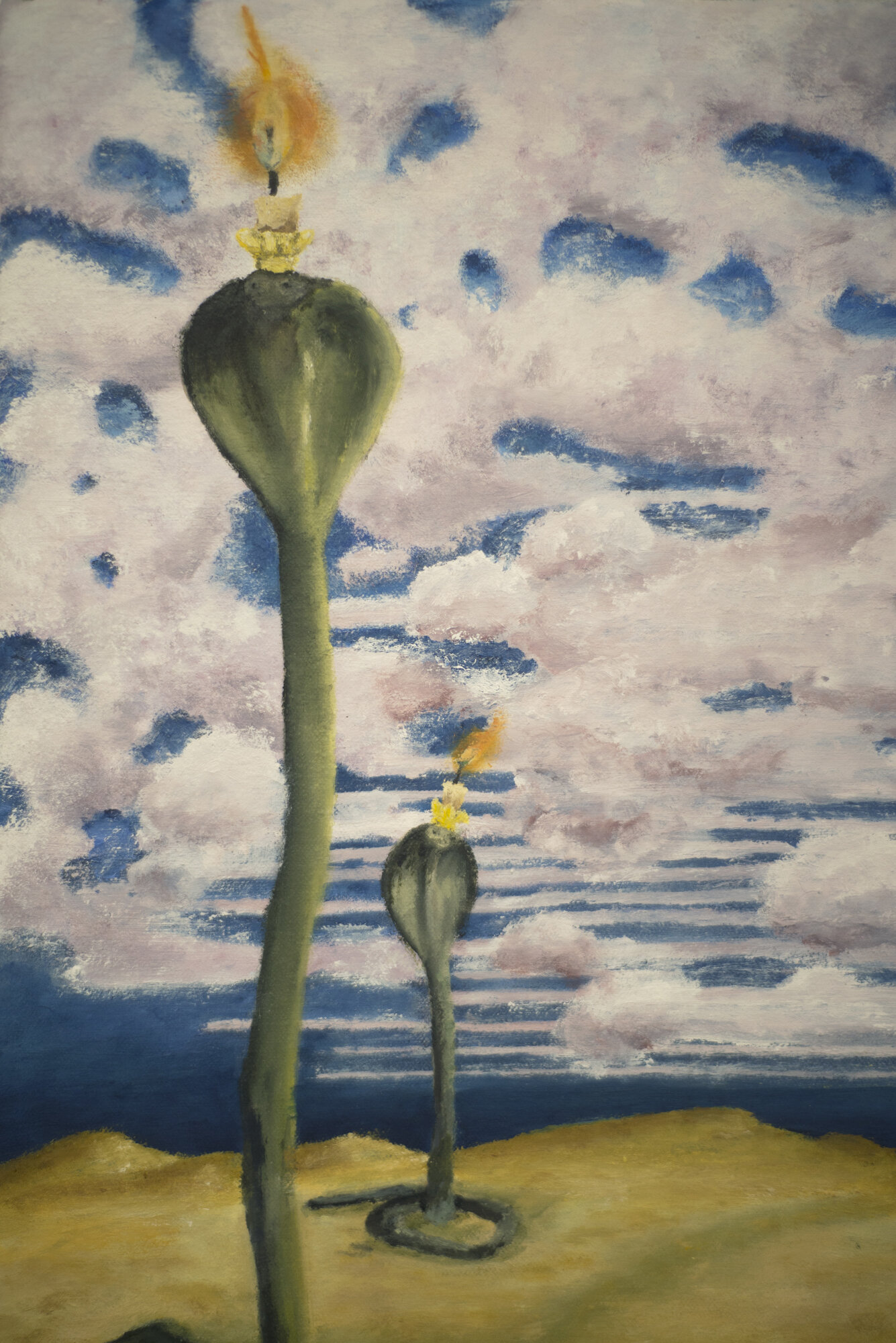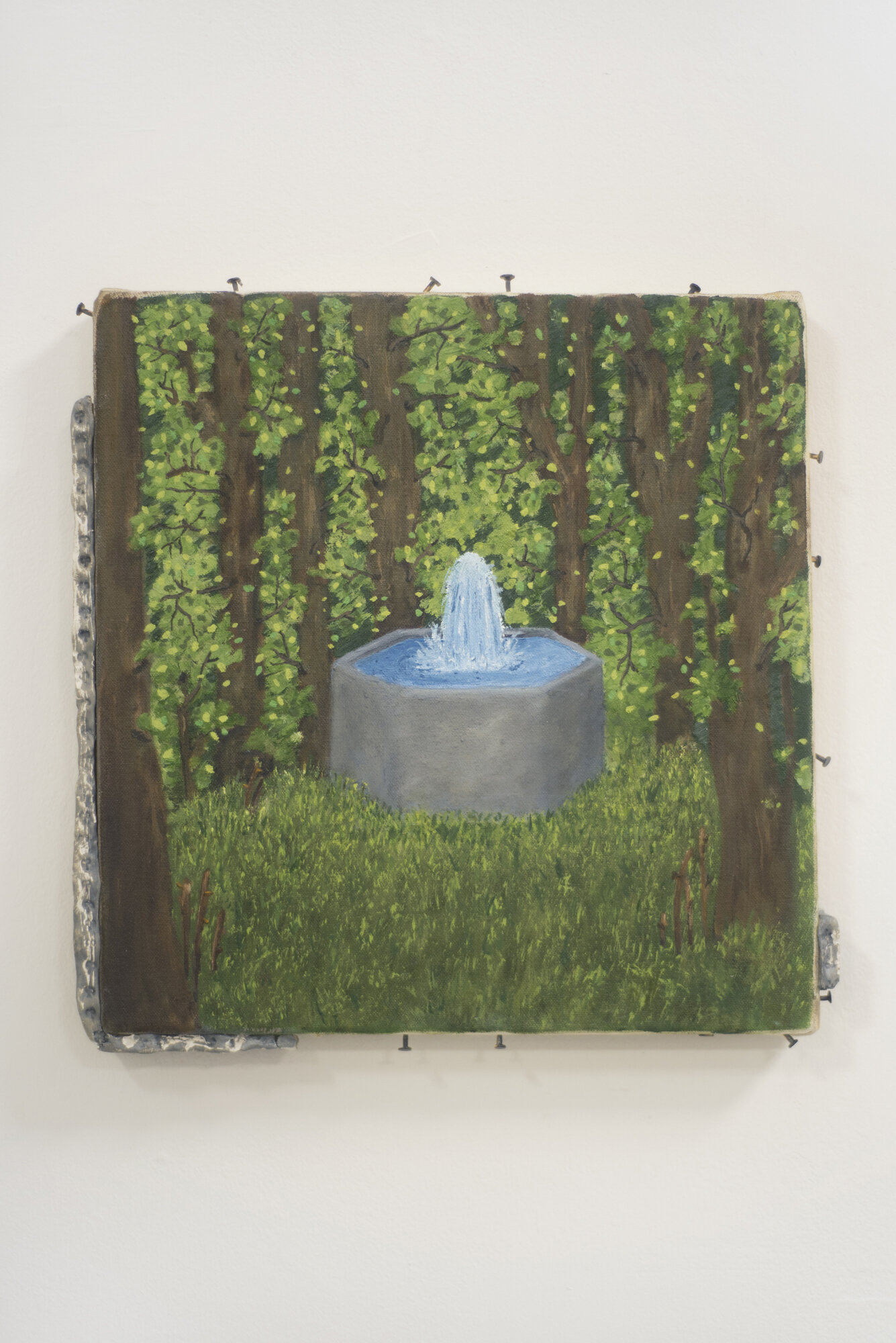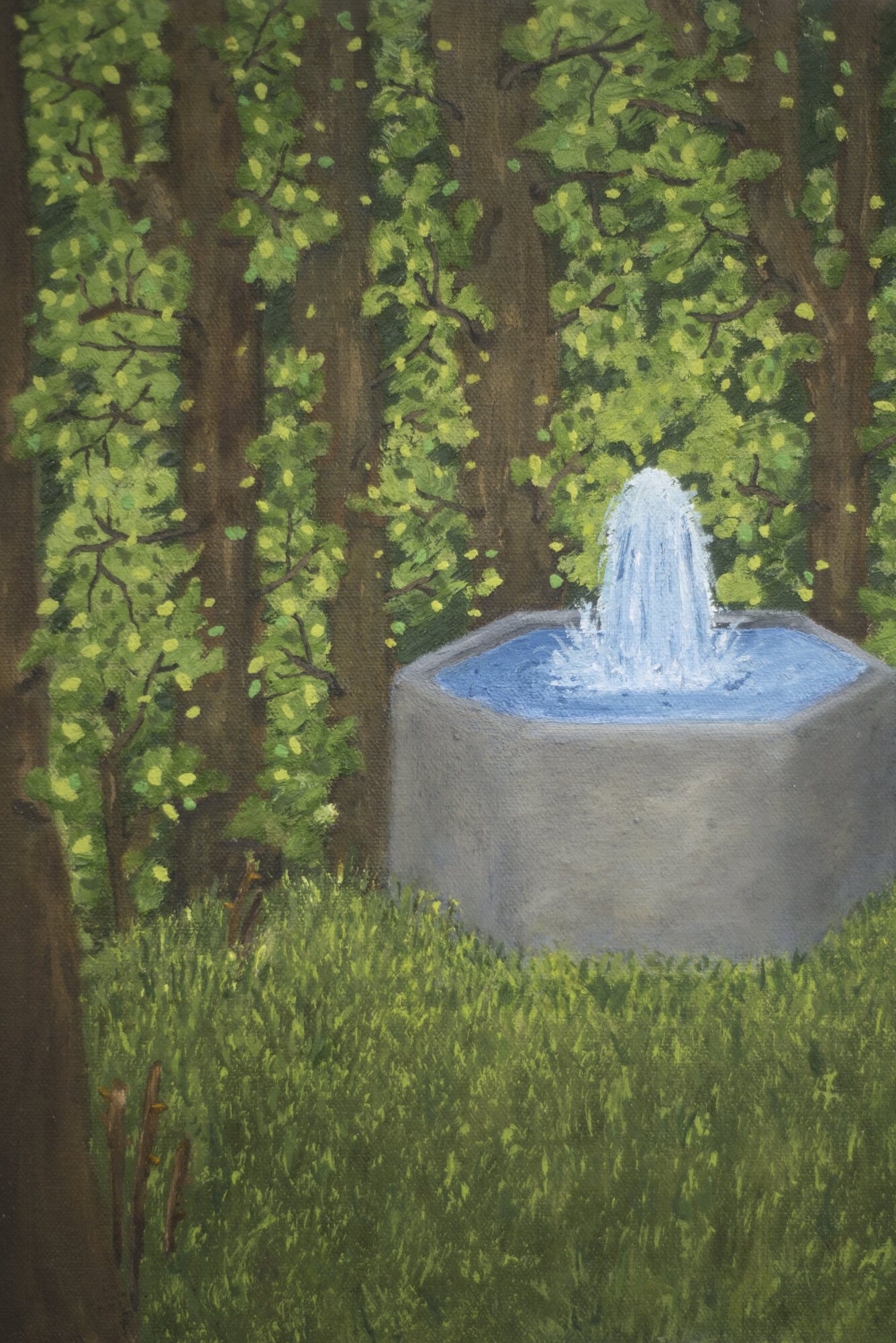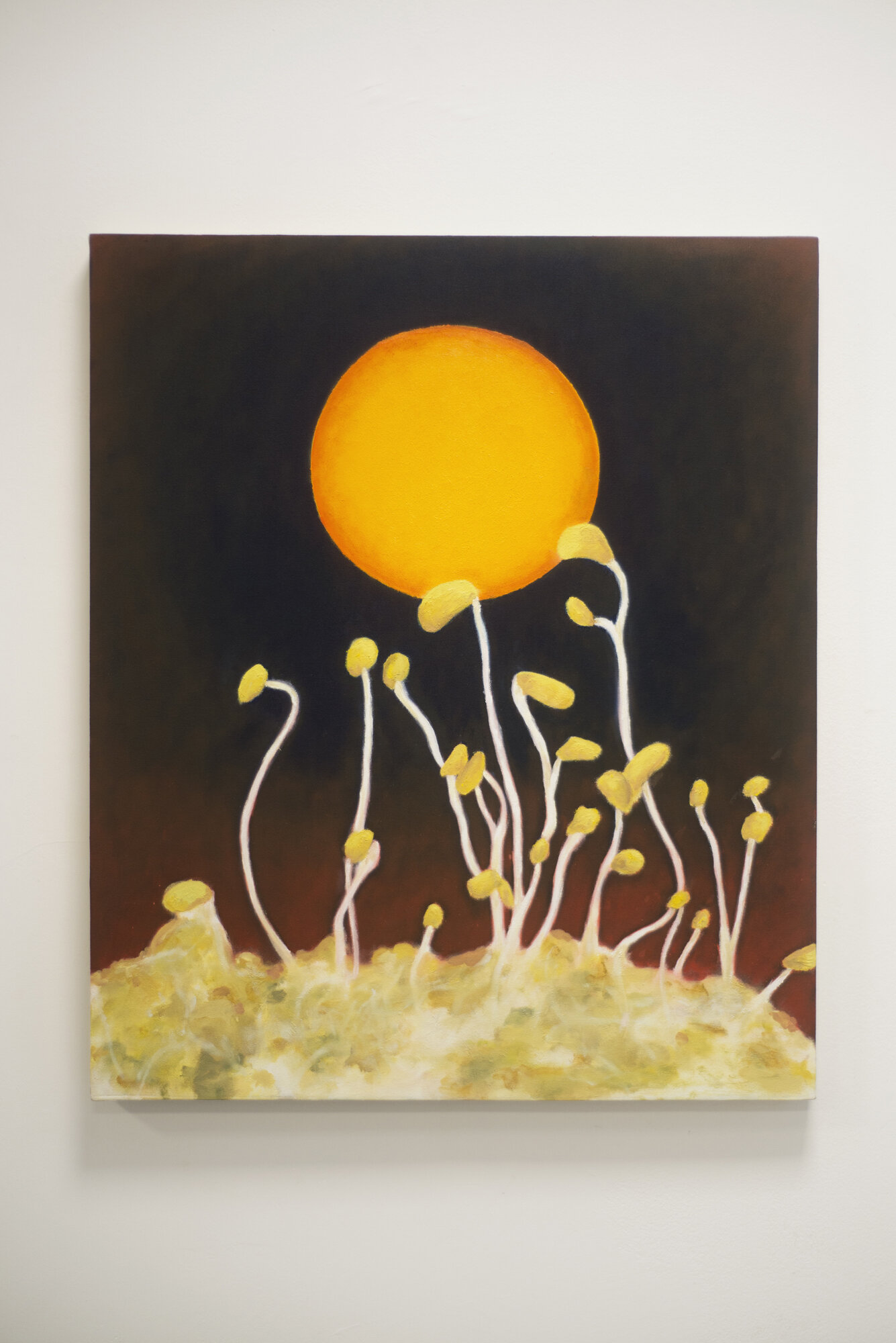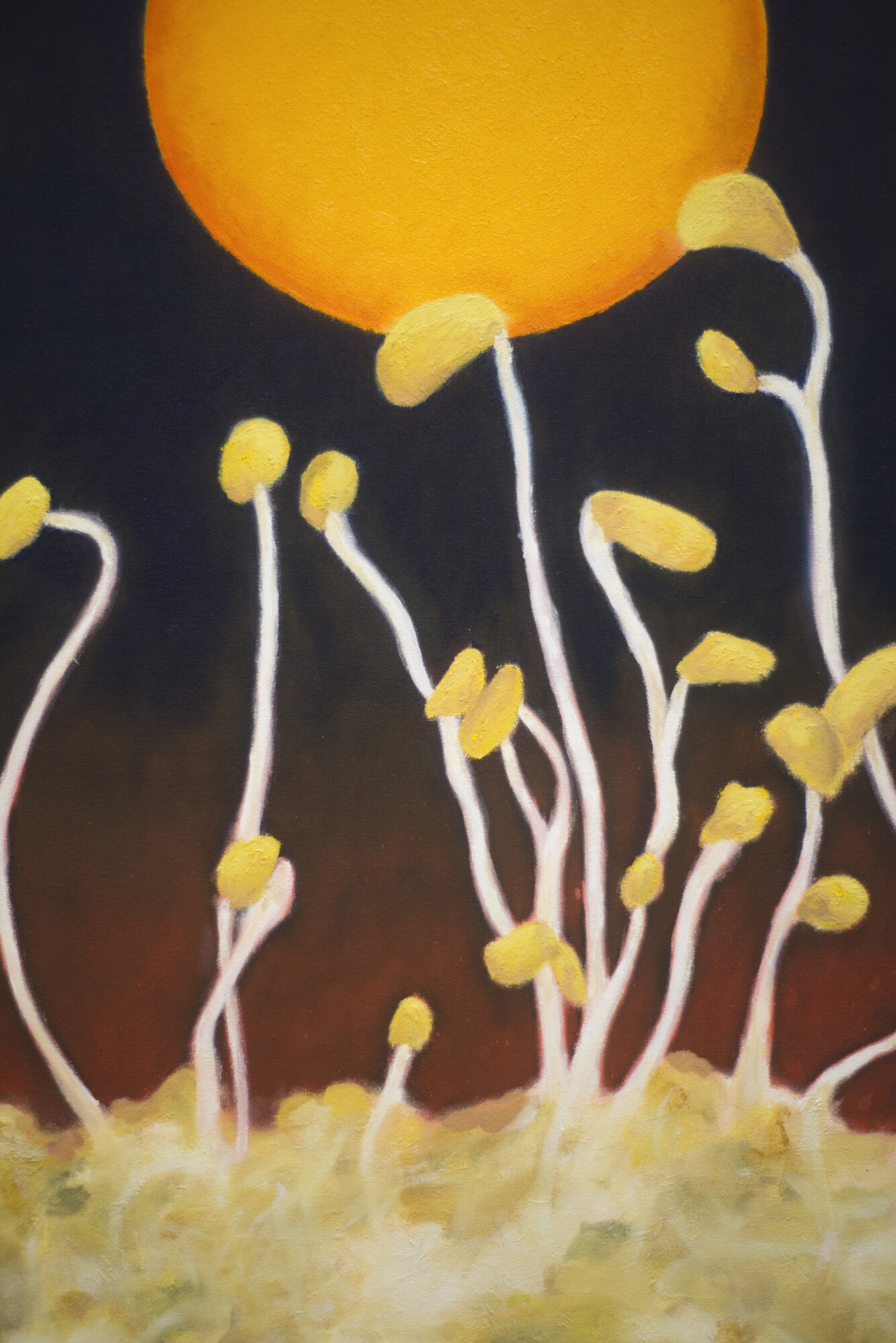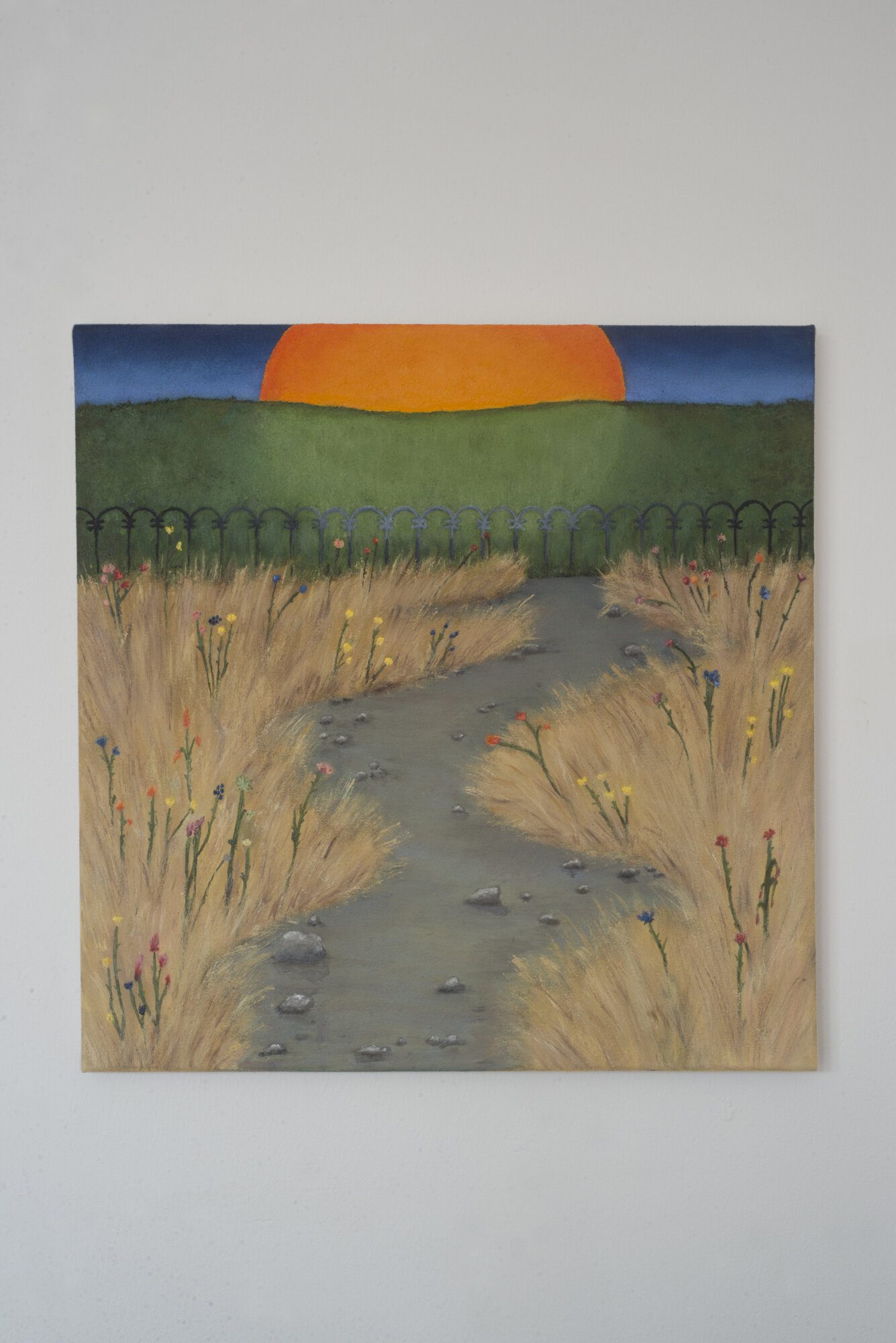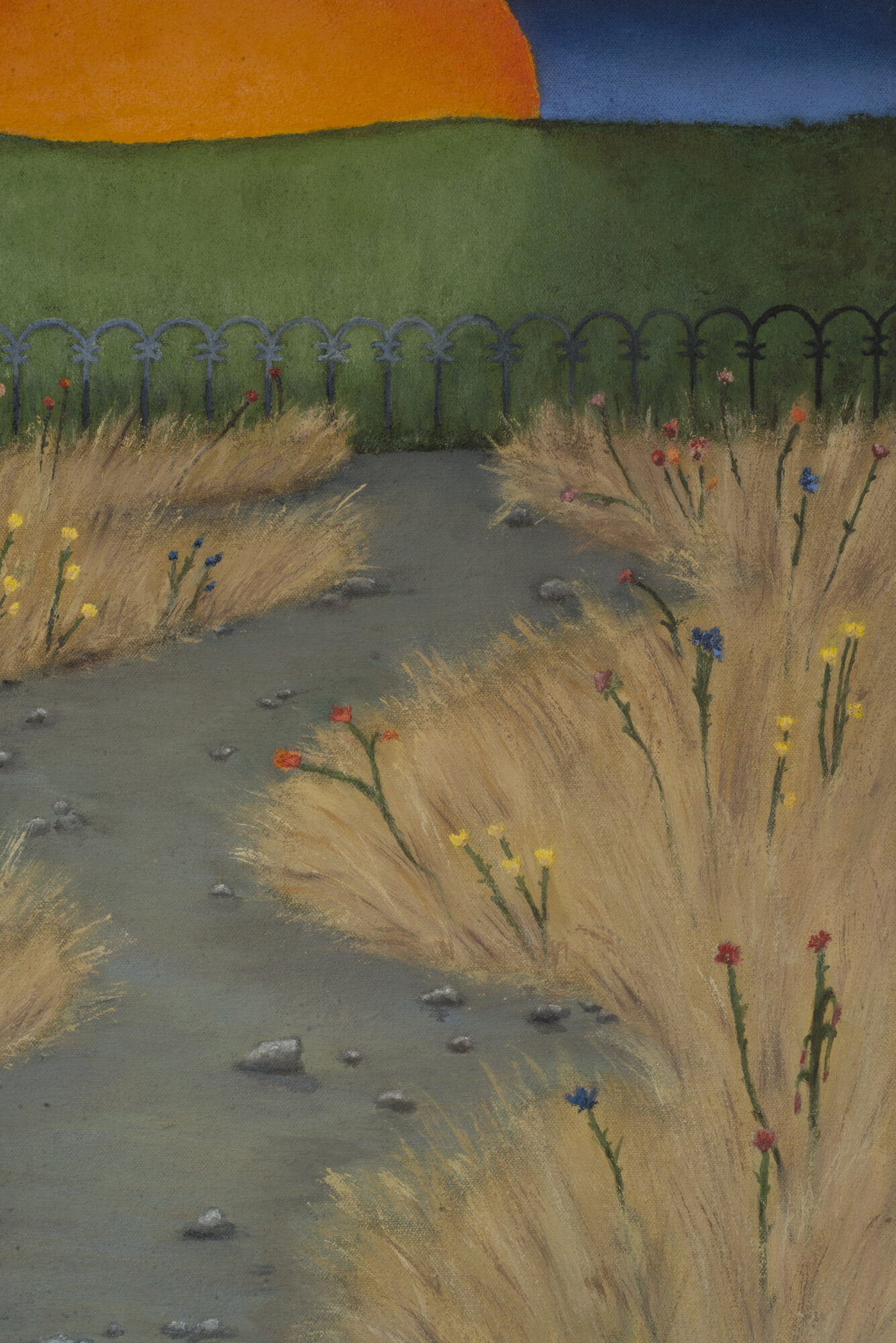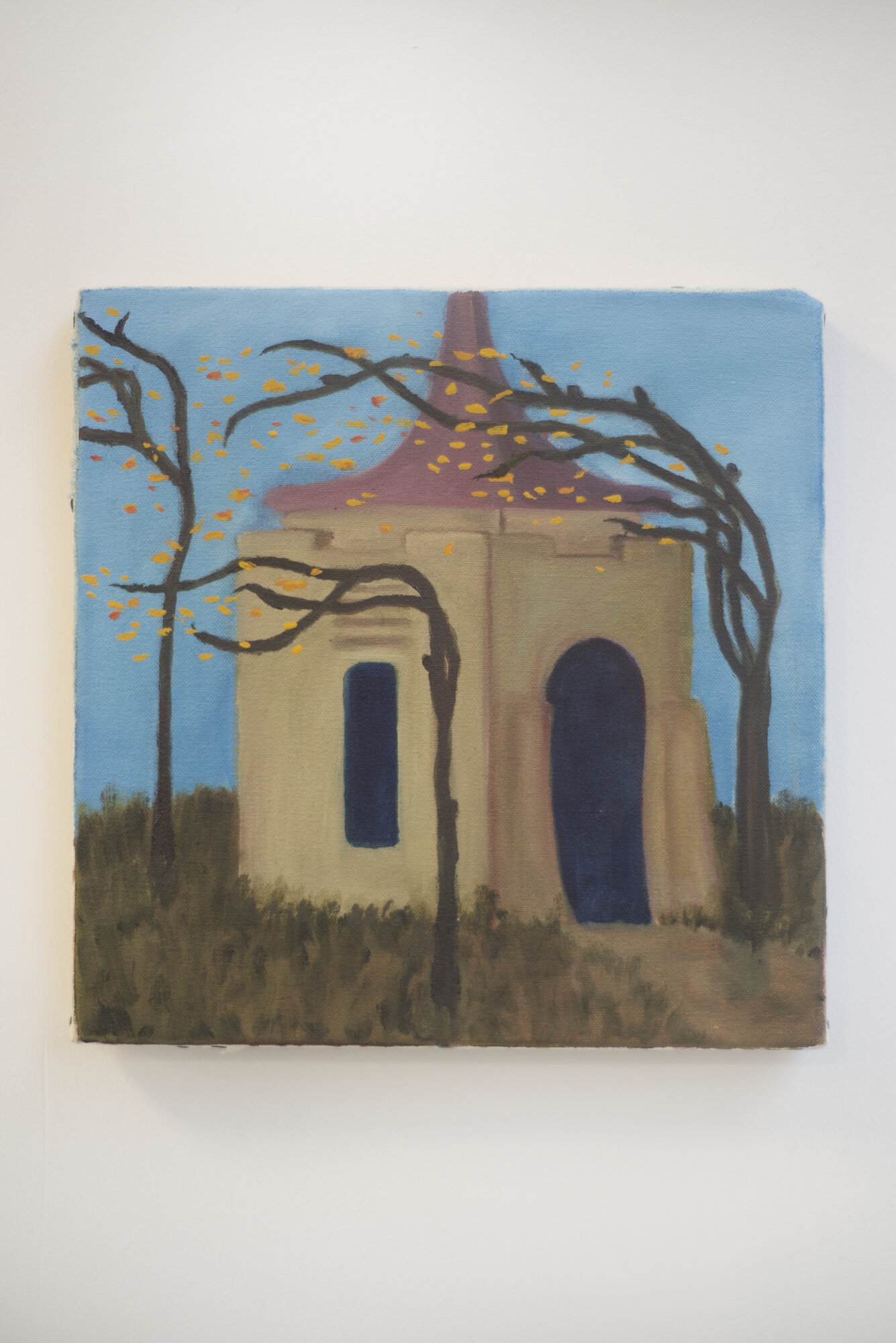Long Time Listener, First Time Caller
Patrick McAlindon
December 7 - December 21, 2019
@
Lunchtime Gallery
32 St Andrews Street
Glasgow
G1 5PD
Email conversation between Patrick McAlindon and Caitlin Merrett King (Lunchtime Gallery) November - December 2019
CMK I first encountered your work in person at degree show and was really taken by the gentleness and depth of your paintings. You presented two sculptural works as well that had a similar softness to the texture of your paintings in a way that they felt like they could have been the subject of one. Firstly, could you speak about the relationship between sculpture and painting within your work?
PM At the time of making those works the two were both linked/necessary in that they sought to take the pressure off of one another rather than allowing emphasis to be put fully on one, they shared the burden of emphasis and had sort of a 50/50 split within their roles. I would say this is because at the time I wasn’t all that sure of myself in my painting ability, or where I found myself most confident/ comfortable, by working across the two it felt like they had the ability to support and complement each other. I was quite late to painting when I decided to start and the idea of presenting a stand alone painting was daunting, paintings can have this definitive quality to them, I was worried it would appear like ‘this is a painting, I am a painter’ and spreading work across the two maybe acted as way a out of being pigeon holed as either.
For a long time I had this hindrance of a thought that just because you paint it, it doesn’t make it ‘art’ so I kept trying to find roles for my paintings, or reasons for doing so aside from the fact I just wanted to. This I realise is a bit silly in hindsight, there can be a very organic collapse between the two roles rather than being too hardline with the usage of each, it’s much more playful/intuitive for me now, I know when to paint a painting and when to make something. The introduction of a sculpture over a painting for me would be when the physical object is able to project and advance an idea more than a painting, similarly I will paint what is difficult or unnecessary to sculpt. They both have their own strengths and there is an appropriate time for both.
Gradually, however, I have recently become much more focussed on painting. I’m just letting go and following through with what feels right and as a result my painting practice has became a little more refined (I hope!) and I’m learning more than I ever have. The use of sculpture/object making is a little more acute now - as my confidence in one grows the necessity for the other wanes. I don’t mean that in a foreboding way or anything, I reckon I will always make things I can’t help it really, it's too tempting to give everything a go.
CMK It’s a confident decision to decide to dedicate your practice to just painting but also a liberating one I think. Maybe the sculpture will come back in again like you say when it feels right! Your approach to painting is so earnest, it’s really admirable how dedicated you are to improving your skill as a painter. When I came to your studio we talked about how you feel like you’re quite a nascent painter, when did you decide to start painting and why?
PM In my head I probably made the decision about 4 years ago but I didn’t put it into practice properly until 2 years ago. I started off studying textiles and the pace and quantity of work required didn’t sit well with me, I could get the work done but there just wasn’t any chance to enjoy doing it and it seemed to never end. I began to dream up this vision of me being in the studio, not being pushed for samples and research and tests, working on something as long or as little as I like. The idea gave me such a strong feeling of comfort and reward, it was irresistible, so I finished the year and switched.
Painting also had a bit of an allure to it too because of how alien it was to me, the idea of studying something that's been around for so long had a sort of monastic quality to it I found appealing and wanted to disappear into, although anyone that’s been through the department will know (for better or worse) it’s not really quite like that, which is one of the reasons I resisted painting for a few years. It was a fun idea though and I really like the idea of slowness and traces of times passing, painting does have a solitary quality to it that can make you feel connected to history at points so I get my kicks there. Recently I am realising that one of the main reasons I paint is because it’s something I can do entirely for myself, in the sense that I don’t have to answer to anyone really when doing it. I was always hung up on making work and asking myself if this is actually coming from me. Is this my voice? Is this an extension of myself? But I think these are questions that can only be answered over time, after persisting with a practice enough to look back and start to notice habits, and it so happens that its painting that has kept my attention and allowed me to continue. There is also a reciprocal relationship between making and looking happening right now where the more I work the more appreciation I have for the work of others. You look and understand whats happening, which is gratifying, or you look and don’t know how it has been done which makes you want to learn and figure it out.
CMK Yeah there is still something very romantic about the solitary painter working away on their craft in their studio and understandably so! But where they interact outside of the studio is with a historical canon of painters and their peers. As you say that’s a really enjoyable context to situate yourself in but also a conflicting one at times, how can I ever compete?
What painters have been most influential to you and where else do you take inspiration from for your paintings?
PM Broadly speaking I enjoy work that has a feeling of otherworldliness to it, or appears to be from another time. When I began painting after school I gradually started looking at the work of the Pre- Raphaelites and Early Netherlandish painting. There is a sense of glamour in the Pre-Raphaelites, it being over the top or a bit fabulous that I find appealing. And the attentiveness in Early Netherlandish work is a very rewarding thing as a viewer. There are also sometimes difficulties in attributing things directly to a single artist and you end up with artists known as ‘The Master of the Embroidered Foliage’ and broad bits of information like ‘probably went to Spain’ which I find quite funny/interesting. In the past these paintings overwhelmed me to the point of disinterest due to the fullness of the images, but now that I can spend longer on my own work I look at these paintings in a more encouraging way.
Some works recently that I have found most important/influential would be: ’The Tree of Jesse’ from the circle of Geertgen tot Sint Jans (c. 1500); ’The Siege of Rhenen’ Master of Rhenen, (c. 1499 - c. 1525) which has some bizarre perspectives going on, and ‘The Tower of Babel’, Anonymous (c. 1490). A few slightly more contemporary names too; Jean Brusselmans, Jane Graverol, Rene Magritte (seem to have a thing for Dutch & Belgian artists), Marsden Hartley, Keegan Monaghan, Alexander Harrison to name a few.
It’s a bit of a difficult question for me. I still tend to shy away from being too prescriptive with my influences because I never want to feel boxed in or be too definitive about my practice since its growing a lot at this stage. As a result there are themes of growth, rebirth, and simultaneously the cyclical nature of life happening across the work.
CMK I've been posting images that you sent me of your preparatory drawings and reference materials taken from books on the Lunchtime instagram account, I think exposing these
references that underpin your practice is really interesting and generous to a viewer of the final paintings and exhibition. The themes you mention in relation to time passing feel significant when I think about the exhibition you did at The Glasgow Guild and the presentation of lots of vases of flowers alongside the paintings. Flowers as a symbol of life and growth. Can you speak a bit about this exhibition?
PM At that show there was a similar time thread running through it looking at bells as a way or alerting, of starting or ending something. The show was an inauguration of the workshop’s gallery space, it was actually meant to happen in time for Christmas but it ended up happening as spring began. Bells themselves are often lost to time, either stolen, lost or smelted into weaponry during wars. Tower bells have quite fitting part names too: a crown, a canon, a lip, a mouth. Glasgow also has a lesser known history of producing bells, the records of production are very unreliable with a handful of firms casting on behalf of others who then took the credit. Somewhat similar to attributing paintings to unknown makers. I also saw bells as something that transcends history, adapting itself and staying necessary. The inclusion of the flowers was to further the participatory aspect. Guests were able to ring bell pulls that I had made and I requested people to bring along flowers to fill the vases that were also donated, so the space grew as the evening wore on and the bells rang. The flowers were another way to emphasise time, with flowers that were growing wild at the time and a visual expression of the incoming season.
CMK I love that participatory aspect where the audience are invited in to contribute to the final composition of the show. There has been a growing curatorial aspect to your work, you’ve put on two shows in the past year with yourself and other artists in your own flat. It feels really celebratory and also a very Glasgow tradition! Will you continue working in this way?
PM It really is a tradition and maybe also a bit of a right of passage, especially at West Princes Street. Its not uncommon to meet people in Glasgow who have lived in that block at one point in their lives. There was a feeling of wanting to contribute to the building’s history and to the community in Glasgow. I would have regretted not putting on a show there. One of the main reasons for putting on shows whilst there was to get people together and introduce overlapping circles which is why group shows are so important to foster a sense of community. Even if I was incredibly nervous organising them, it was always worth it in the end. Its interesting seeing how the art scene changes over the years in Glasgow but still being hosted in the same block of flats. For example if you look up ‘Hotel Gilchrist’ you can see some action from 2005. For me, putting work in alternative spaces offers another element for the audience, there’s something intriguing about being in a space that’s not purpose built for the occasion. There can be a bit of play between the work and its setting, helping to dictate placement or framing things in a certain way. There is definitely potential for me to organise more shows, but I don’t think it will be where I live next time. I understand the need for the tradition though, Glasgow has an abundance of unused and alternative spaces but its quite difficult to get access even if you are willing to pay!
CMK Now you’re returning to a gallery space and doing a show of just your own work here, how do you feel about these new paintings?
PM I had a sort of don’t run before you can walk attitude towards painting when I began, starting out more ambiguous and then gradually pushing myself to become less so. Working consistently on painting for this show has really given me more ownership over painting in general, becoming more ambitious within my work. Figuring out what I get a response from and where my work is leading to. I’m trying not to rely as much on interpretation as to what is there formally, it’s clearer what I am offering in terms of subject matter but the motives are still quite subtle.
Patrick McAlindon lives and works in Glasgow. He graduated from BA (Hons) Painting and Printmaking in 2019 with an exchange semester at the Academy of Fine Arts Vienna. He is currently working on a publishing project looking at homes in Scotland with collaborators Dr Charlie Lynch and David Sillars.
Recent exhibitions include, ‘Little Bouket’ with Paul McKee and Daniel Pettitt, 49 West Princes Street; ‘Bring your own flowers’, The Glasgow Guild; and ‘Get lucky sound of the summer’ with Sarah McCormack, Jessie Whiteley, Hamish Chapman and Suds McKenna, 49 West Princes Street (all 2019). The other exhibitions in this series were by Nat Akinyi, Amy di Rollo and Siri Black.
This is the fourth and final exhibition in a series of shows showcasing the work of graduates from BA (Hons) Fine Art at the Glasgow School of Art this year. Other exhibitions in this series were by Nat Akinyi, Amy di Rollo and Siri Black.

